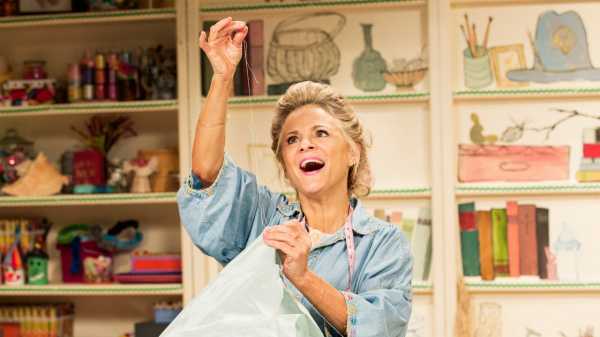
“At Home with Amy Sedaris” (truTV) might be best described as a deviled egg spiritually possessed by an imp of the perverse. The cult celebrity of its charming host rests on the satirical platform of Comedy Central’s “Strangers with Candy,” but “At Home,” created by Sedaris and Paul Dinello, is not exactly a spoof. Although the show often exaggerates the Wonder Bread textures of heirloom cooking shows and lampoons the weird frequencies of daytime local TV, there is not too much ironic distance on offer. It’s a heartfelt, crackpot homage, with an independent creative vision. It shares its lineage not only with “The Frugal Gourmet” and “The Martha Stewart Show” but also with F. T. Marinetti’s “The Futurist Cookbook” and Kingsley Amis’s top-drawer advice on bottom-shelf liquor. To call the show “quirky” would be lazy, especially when the word “demented” is sitting right there. It’s a homemaker’s talk show elaborated as a Dadaist carnival.
Sedaris’s immediate literary forebears are her own hardcover hospitality guides, “I Like You: Hospitality Under the Influence” and “Simple Times: Crafts for Poor People,” the latter of which is out of print and won’t be returning until its publisher does something about the getup Sedaris wears to model a “peace pipe.” Repurposing these leftovers, “At Home” serves a wackadoo casserole, in which Sedaris plays a version of herself in somewhat the same sense as a child playing house.
At some moments, Sedaris is a cheeseball full of arsenic; at others, a lonely soul bunkered in her craft room. The hostess’s outfits often involve rickrack, and its zigzag harmonizes with her emotional movement from manic peaks to depressive valleys and back again. The real Sedaris grew up in Raleigh, North Carolina, and the show-within-the-show, which is contiguous with the show, purports to air in the Research Triangle area, which lends the sense that we are watching a version of her who never left home and grew roots in soil with the kind of loaminess that you see in David Lynch films. There’s an air of space-age Southern Gothic about the show, like some B-52’s outtake. The episode on funeral traditions is a masterpiece of gallows humor: thoughtful and elegant, she suggests giving a bereaved person “a small plant started from a cutting or sapling,” which symbolizes renewal; crass and practical, she phrases the question of controlling one’s behavior in the moment as, “How do you balance compassion against all the fun things you’d rather be doing?”
Sedaris opened the pilot of “At Home,” in 2017, by preparing “a complete fish dinner with all the trimmings,” but which also included lamb chops, because her guests were carnivorous hedge funders; she noted that red snapper is “known for its firm texture and abundance of mercury—perfect if slowly poisoning a loved one is on the menu.” In character as Patty Hogg, a braying neighbor with a fussy bouffant, Sedaris advised spacing the chops an inch apart on the grill, above briquettes that have turned a “country-mouse gray.” A postprandial segment found Sedaris-as-Sedaris sporting a hideous rash—one of many visions that call to mind a Cindy Sherman grotesque. Somewhere in there was an extremely funny faux commercial for the Mercedes-Benz of breakfast condiments, “the official syrup of the Third Reich.”
In its second season, Amy’s kitchen has undergone a modest makeover, and all the production values are a notch higher. The lemonhead yellows and candy-apple reds are almost painfully sweet, which intensifies the skewed dreaminess of the scene. The camera catches the magnetic-knife strip in the background at a more forceful angle, as if it’s putting Chekhov’s gun in its crosshairs. Meanwhile, the coiled cord on the avocado wall phone tethers us to a Ladies’ Home Journal twilight zone.
“At Home” has become less entertaining but more intriguing—more haunting than humorous, more strange than ha-ha. Sedaris spends less time supplying advice and more energy meandering into idiosyncratic obsessions with death and solitude. The show seems to acknowledge this drift in a new episode on the theme of fan appreciation. “Really?” Sedaris says, to her crew, with disgust, after the introduction. “Fans? Are we that out of topics? We haven’t done compost yet, or pet caskets.” The episode, titled “All About Amy,” features Rose Byrne as an insinuating Eve Harrington figure and develops as a whimsically morbid riff on monomania. Beyond a mention of punching up Salisbury steak with French-onion-soup mix, it scarcely adheres to the premise, but what matters is the weird catharsis it provides. Lifting a warped mirror with an agitated hand, “At Home with Amy Sedaris” ultimately proves as soothing as a Bob Ross tutorial.
Sourse: newyorker.com






